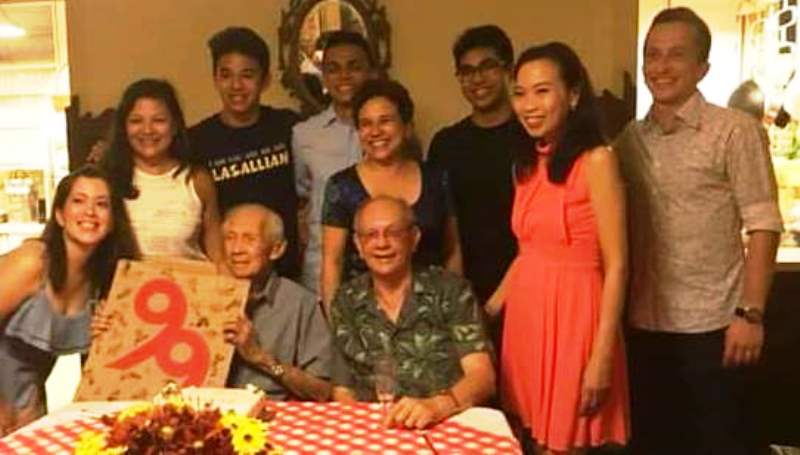
HE was so very close to a landmark 100th birthday but Gerard Clarke signed off quietly just three months short of deservingly earning the honour of a celebrity centenarian.
A rousing stalwart of the Padang Eurasian community from the post-war era, he passed away at the Tan Tock Seng Hospital on Sunday after a prolonged bout of pneumonia, say family members.
He was an awe-inspiring member of the Singapore Recreation Club (SRC) for about 83 years and the longest serving club member will be fondly remembered for his “gentleman traits” as a superlative sportsman and soft-spoken socialite.
Mr Clarke is survived by son Gerard John, 68, now settled in England, and daughter Louise, 64. His wife, Margaret, passed away after the couple celebrated the 60th diamond anniversary in 2007 at 84 years.
Dad was Conrad Clarke, a prominent Eurasian sports personality, who donated an influential cricket trophy (Conrad Clarke Cup) for The Rest XI versus The Europeans in the mid-1930s.
The Clarke family of six excelled in sports in their respective spheres, from athletics, hockey, football, rugby and netball. Mr Clarke was the oldest son and third youngest in the family – Mercier, Zena, Dot, Andrew and Albert. The next generation of Clarkes also continued to hog the international headlines, the most famous in Farleigh, who ranked in the 1970s among Asean’s finest hockey strikers.
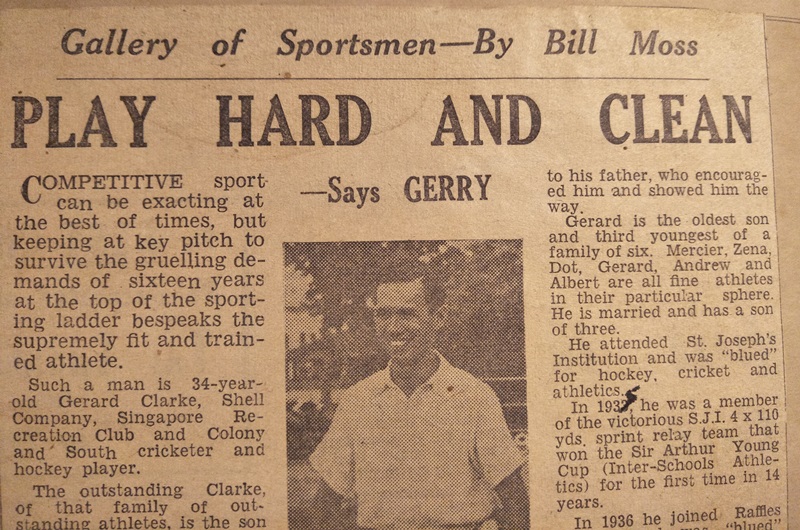
‘PLAY HARD AND CLEAN’
Louise recalls a newspaper interview in The Singapore Free Press her dad gave where he expounded the virtues of “play hard and clean”. The Gerard Clarke mantra: “Play the game in the spirit of true sportsmanship, play it hard and clean. Be open to constructive criticism as it lends room for improvement.
“Mark, read and digest, the action of famous sportsmen and above all, a man is not so great that he can’t learn a trick or two from a more experienced sportsman.”
Born September 20 1918, Mr Clarke was a double international. He excelled at hockey (from 1939 to 1951), three years for the South (1947 to 1949) and at cricket, too. Sad that in 1951, at 33 years, due to ill health, the strain of competitive sports crept in and his top-class sporting days were over. The national newspapers reported that the “Colony has lost one of its finest sportsmen”.
Louise, a retired educational psychologist, says: “He was looking forward to his 100th birthday. We were planning a grandest centenarian bash. We had a sports theme for his 90th and a fun 1920s theme for his 95th at our St Francis Road home.
“Dad was always in good spirits. He relished life and still drank his Guinness stout at lunch and had a tot of whiskey, his favourite bottle was ‘Famous Grouse’ just before dinner every day.”
Poignantly, Louise says: “Yes, dad would have been disappointed not to make 100 years. But as a cricket lover, who consistently hit a number of centuries as the opening bat, he knew deep in his heart that as a team-sportsman, a score in the nineties is as good as a hundred!”.
Like majority of Eurasians in the post-war era, Mr Clarke studied at St Joseph’s Institution (SJI) and was “blued” (decorated) for hockey, cricket and athletics. At 17 years in 1935, he was a member of the victorious SJI 4×110 yards sprint relay team that won the Sir Arthur Young Cup (Inter-Schools Athletics) for the first time in 14 years, beating arch-rivals Raffles Institution. The following year, 1936, he joined Raffles College and was “blued” for cricket, hockey, rugby and athletics. For two years, he was elected captain of the Combined Colleges hockey XI.
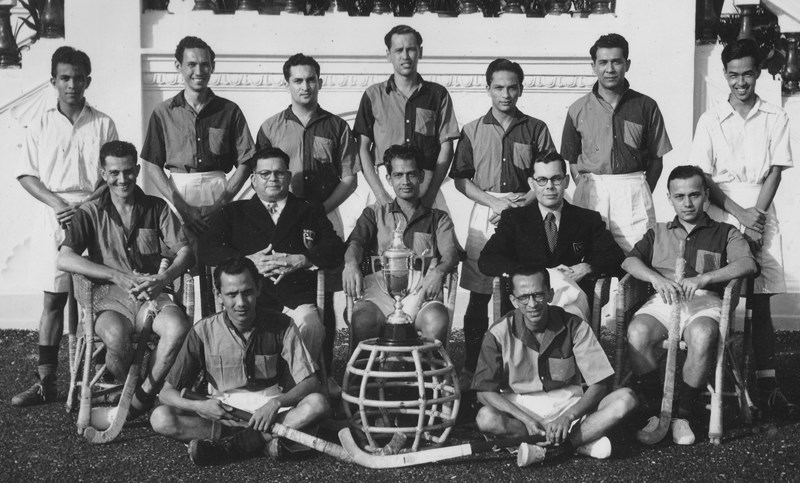
OUTSTANDING ALL-ROUNDER
As an outstanding all-rounder SJI schoolboy, he followed his father’s footsteps to join the Singapore Recreation Club (SRC) and from then until 1951, he was an exemplary hockey midfielder and at cricket, excelled as the opening batsman.
SRC President Dr Sarbjit Singh, an orthopaedic surgeon and first Sikh to head the Padang club in 134 years, saluted Mr Clarke’s “extraordinary contributions on the Padang”. He praises: “Even in the later years of his life, in the late 1990s and early 2000s, Mr Clarke was a regular at our bi-annual ‘Cheers to Years’ event for SRC members with two decades to show. He’s the longest surviving pioneer Padang member and, by all club records, he had done the Clarke family and SRC proud.”
Former SRC committee member and icon SJI teacher Peter Martens recollects how Mr Clarke “helped re-start cricket and hockey after the Japanese Occupation”. He says: “He was an accomplished cricketer but always found time for the youngsters, including me. He was always kind and patient and he played a big role in setting up Shell Sports Club for staff as well as other youngsters.”
In a nutshell, Mr Clarke personified the best of SRC, ever since its founding in 1883, as the Padang club held the distinction of being a family-oriented club, always encouraging the younger generation, with the principle objective being the encouragement of sports. In particular, St Joseph’s Institution, a stone’s throw away at Bras Basah Road, was adopted as a feeder sports nursery, with stalwart hockey, football and cricket players regularly wearing Padang colours.
Former Singapore football international John Fernandez, from the Singapore Cricket Club (SCC), says: “His passing is a great loss to Singapore sports, more so to the Eurasian community. In my mind, the Clarke family lived and breathed sports. They are a rare breed of Made-in-Singapore sporting personalities.”
Mr Clarke’s neice, freelance journalist Denyse Tessensohn summed him as a “beautiful gentleman…who spoke only good of people and never an ill word crossed his lips about anyone”.
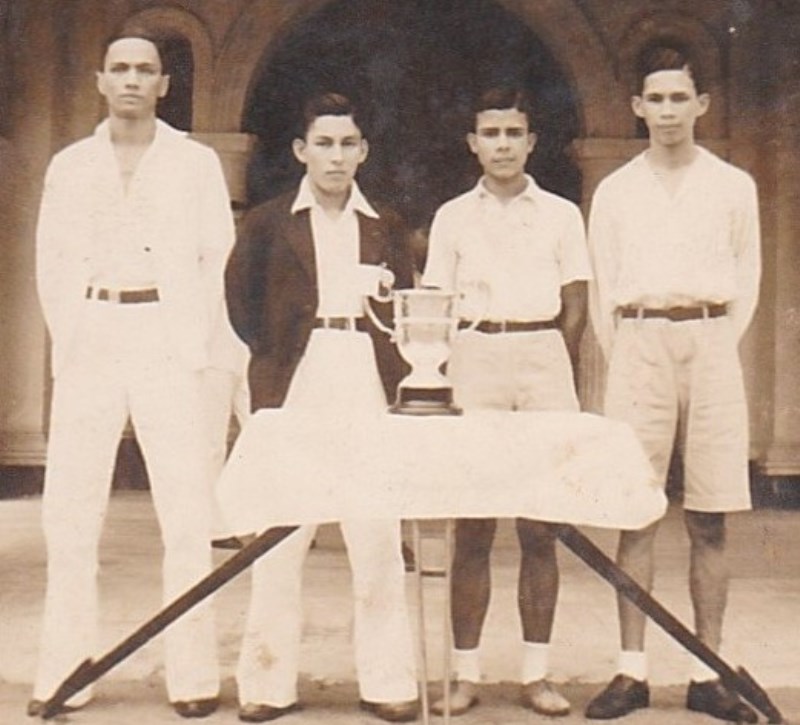
SPORTING TRADEMARK
If ever he had a sporting trademark, Mr Clarke bonded passionately with cricket, which was the elite sport during the post-war era on the Padang with the European-only Singapore Cricket Club (SCC) at the other western-end. He played a quiet, yet smart, role at the Eurasian-end. Rugby was later introduced and played in 1938 and while hockey, tennis and football were played to enthusiastic support, cricket remained the lead sport at both Padang ends.
Another neice, Valerie Clarke Villamil in Perth, West Australia, poured out thoughts over Facebook at the loss of “my 99.9 year old uncle”. She wrote: “A very sad time. I’m really feeling heart-broken, May he rest in peace in the arms of his loving God who he had great faith in. Blessed prayers for your journey, Uncle ‘G’.”
Mr Clarke’s most celebrated nephew was Farleigh Clarke, arguably one of the finest sportsmen from St Joseph’s Institution, who went on to be one of the deadliest hocjey strikers in the region. He was a member of the 1973 SEAP (South-east Asia Peninsular) Games hockey gold-medal team – the first and only time Singapore turned the tables over odds-on favourites Malaysia with a 2-0 win at the Jalan Besar Stadium,
Farleigh, 65, says: “My late dad (Andrew) starred for Singapore in a number of sports but my uncle (Gerard) will be remembered for his elite all-rounder sportsmanship and always giving nothing short of 100 per cent, especially at cricket, where he was an unmatchable opening batsman.”
Personally, when I was in the SRC management committee in the 1990s, I recalled the soft-spoken conversations with Mr Clarke, then still looking sprightly in his 70s, as he talked of the Japanese Occupation in the 1940s, where the bombs and bullets, dramatically changed the green-grass Padang façade.
I marveled how Mr Clarke knew the history of the club at the tap of his fingers from the time the clubhouse was formally opened on September 2 1905, by the Governor of Singapore, Sir John Anderson. The addition of two wings was completed in 1931 and declared open by club president Dr Noel Clarke.
He was like a walking dictionary on Padang affairs as he was in the thick of action, too, at the SRC annual general meeting in 1948, when member P.F. de Souza proposed that the club should be open to non-Eurasians. And this proposal, though not immediately accepted, gained more support over the years. In 1955, ordinary membership was opened to people of all communities. A year later, in 1956, women were admitted as members for the first time.
Today the Padang is mainly used for public and sporting events – even the iconic National Day parades — but in the 1940s, as Mr Clarke recalled, it felt more forlorn footsteps when the invading Japanese forced the entire European community onto the field. There they waited while the occupation officers dickered over a suitable location for the “conquered.” They ordered all British, Australian, and Allied troops, as well as European prisoners, on the 22km march to the prison camps at Changi.
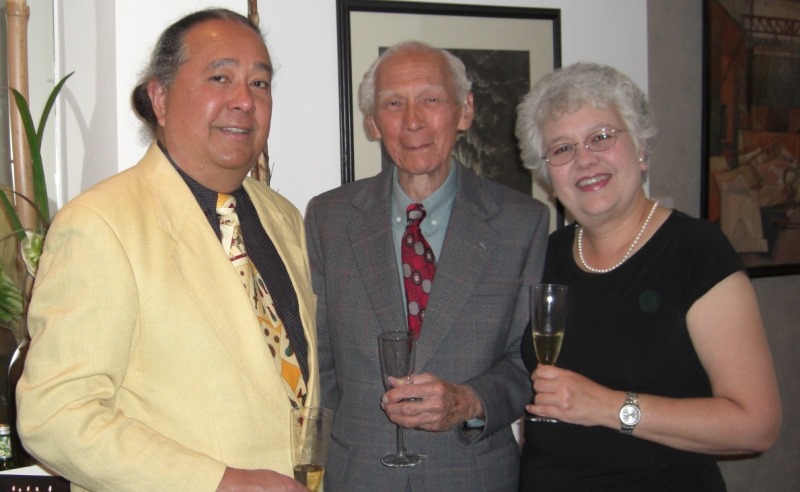
YEOMAN SERVICES
But it was in the bat-and-ball sport of cricket that Mr Clarke showed his true sportsman character and he opened bat for “uncountable state matches”, recalls Denyse Tessensohn, who also authored the commemorative SRC Book. “He will be remembered as a first-class sportsman and off-the-field, he also had a big heart to help the less fortunate and quietly gave yeoman service to his fellow men and church.”
Former SEAP Games 1973 gold-medal hockey striker Nantha Kumar, now in Mooroolbark, in the Australian state of Victoria, dropped me a quick e-note: “Mr Clarke always had a very gentle smile and a word of positive encouragement. Must be the SJI-SRC thing. I remember him very well as a remarkable Padang role-model. May his soul rest in eternal peace.”
Among Mr Clarke’s famous sporting mates was the late Minister for Law (1964 to 1988) Edmund William Barker, popularly known as Eddie, who was hailed as “The People’s Minister”. He was a superlative sportsman, Queen’s Scholar, successful lawyer, Cabinet minister, and how much Singaporeans benefitted from his accomplishments.
Former Singapore Cricket Association (SCA) Vice President M. Neethianathan, a triple international at cricket, hockey and football, recalls Mr Clarke as a “much respected cricketer who was a fine gentleman”. He was a founder of the Non-Benders (NB) cricket team and pioneered the D’Almeida & A. P. Rajah Trophy with NB playing an annual series with Combined Schools.
“This trophy competition led to the nurturing of several promising schoolboys who made the international grade like Keith Elloy, Ishwarlal Kassim, Shariff Rashid, Julian Hoe Sang, Jayasundram Param, Chandralingam, P K Sundram and Gopal Altaff,” he says.
“I fondly recall in the mid-1990s when we invited Mr Clarke, then in his mid 70s, for the SCA awards ceremonies and he always obliged. He unfailingly had a nice word for the younger players, always motivating them to give off their best with the bat-and-ball and also academically in school.”
Much as he was a Padang legend, Neethianathan recalls that “his humility surpasses many and he ever uttered anything about his own prowess”.
He adds: “That’s the truest mark of a passionate Padang gentleman. Not a word of his personal achievements. He may have left us but beloved Gerry has left a lasting impression on all those who were fortunate enough to know this spirited sporting icon.”
RIP Gerard Clarke.
The Padang will forever mourn an extraordinary sporting legend, who achieved his goals in the humble and quiet way, without the fiery fanfare or fireworks.
Farewell Uncle “G”, as his Perth-based neice, Valerie Clarke Villamil, passionately bid goodbye to “my 99.9 year old uncle”.
The body is resting at the Clarke’s home at 96 St Francis Road, off St Michael Road/Serangoon Road. The cortege leaves on Wednesday for mass at the Church of St Michael at 2,30pm and thereafter to Mandai Crematorium Hall 3 at 4.30pm. – By SURESH NAIR.
- Suresh Nair is a St Joseph’s Institution (SJI) Alumni and joined Singapore Recreation Club in the mid-1970s. He was in the SRC management committee, rising to be the Vice President during the mid-1990s, the critical years of the Padang club redevelopment.

































